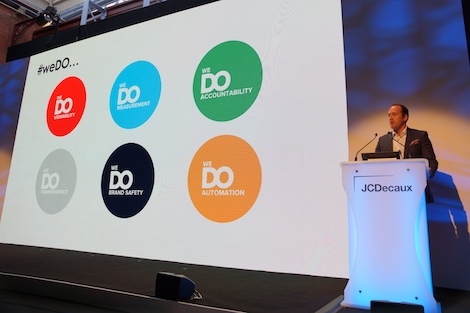Adrian J Cotterill, Editor-in-Chief
Earlier this week, JCDecaux, the UK’s market leader in Digital Out-of-Home, announced its move towards automated trading and planning that will give partners seamless access to its 48% market share of digital viewed impressions (source: Route 24) in the UK.

To accompany this automated platform, JCDecaux also launches its industry-leading brand charter, named BranDO, to outline the automated trading standards that the company will adhere to. BranDO comprises a set of guidelines on the issues of viewability, measurement, accountability, transparency and brand safety, providing a blueprint for JCDecaux as it moves towards a more automated delivery model.
After two years of substantial investment, JCDecaux UK is launching its cutting-edge trading and planning supply side platform (SSP) that features an integrated content management system and a rich geo locational data management platform (DMP). The SSP uses IAB OpenDirect and OpenRTB protocols to enable connections with existing trading partners and emerging trading platforms. The integrated DMP incorporates data from Telefonica, Route, CACI and YouGov, while the SSP offers programmatic functionality to bring automated trading across JCDecaux’s national portfolio. The CMS will enable seamless content management, with personalisation and contextualisation for increased campaign relevance.
Spencer Berwin, Co-Chief Executive Officer at JCDecaux UK, told us “This is a landmark moment for JCDecaux as we launch our brand charter, BranDO. At the same time we are launching our automated trading platform, which signifies the transition to trading viewed impressions rather than frames. The online industry has provided incredible innovation when it comes to ad delivery. Along with this innovation comes a real responsibility to advertisers.
“Launching at the IAB Digital Upfronts represents our commitment to be a top five digital media owner. As we announce our automated trading capabilities, we are launching BranDO to be the framework for quality standards in DOOH. We must maintain advertisers’ trust and create working practices that ensure a brand safe environment. We are committed to growing the medium through a new automated platform by putting the advertiser at the heart of what we do.”
The aim of the BranDO charter is to ensure that one adheres to quality controls as the industry moves towards a more automated future:
- Viewability – We will only measure ads that have been ‘viewed’ using the JIC-approved Route audience measurement system. This means ‘eyes on’ ad copy rather than an opportunity to see (viewed rather than viewable). We will only count real people and only those resident in the UK aged 15+.
- Measurement – All audience-viewed impressions will be published. We will provide the raw viewing logs that can be used for verification. Any data enrichment on top of the Route viewed impressions will be made available to all parties to the trade.
- Accountability – Playout reports direct from the media player will be published including any hardware or software issues. The process will be independently audited via PwC. A report on viewed impressions traded and viewed impressions delivered will be made available during and after the campaign.
- Transparency – We will publish a quarterly report at a global level of campaign compliance.
- Brand safety – We will have the highest regard for brand safety including the security of our networks. We will utilise the highest quality screens and definition for a brand safe canvas. We will ensure the build and locational quality of all our screens to ensure the environment of display is brand safe. We will comply by all legal and regulatory frameworks and ensure we strive for the highest standards in sustainability, health and safety.
- Automation – Automated trades will use the IAB approved OpenDirect and OpenRTB protocols. Copy will be approved to meet ASA and local authority standards for display in a public space.

Follow DailyDOOH